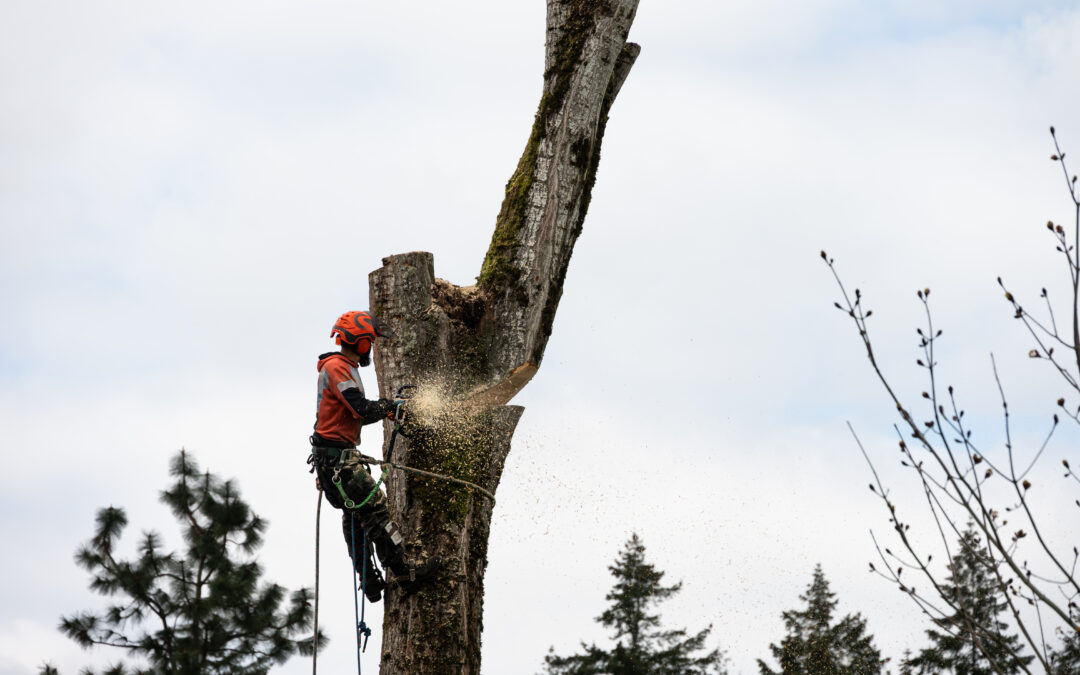Trees add beauty, shade, and value to your Utah property but when a tree becomes damaged, diseased, or dangerous, removal may be the safest option. Many homeowners aren’t sure when a tree can be saved through pruning or when it has reached the point where removal is necessary. Catching the warning signs early not only protects your home and family but prevents costly damage from falling limbs or unstable trunks. Here are the most important signs you need professional tree removal.
1. The Tree Is Dead or Dying
A dead or severely declining tree is one of the clearest indicators that removal is needed.
Warning signs include:
- No leaves during the growing season
- Brittle branches that snap easily
- Bark falling off or peeling excessively
- Large areas of decay or hollow trunk sections
Dead trees lose structural strength quickly, making them a major hazard, especially during Utah’s high winds and winter snowstorms.
2. Visible Disease or Pest Infestation
Some tree diseases can be treated, but others progress rapidly and compromise stability.
Common symptoms include:
- Cankers, oozing sap, or discolored bark
- Fungal growth (mushrooms) at the base of the trunk
- Sudden leaf loss or thinning canopy
- Multiple branches dying back at once
If pests such as borers, bark beetles, or carpenter ants have taken over, the internal structure of the tree may already be compromised.
3. Major Storm Damage
Utah storms can cause significant damage, especially to older or weakened trees.
You may need removal if the tree has:
- Split or cracked limbs
- A partially broken trunk
- Uprooted roots
- A canopy leaning heavily to one side
Storm-damaged trees can fall without warning and should be evaluated by a professional immediately.
4. The Tree Is Leaning
Some natural leaning is normal, but a sudden or increasing lean often signals root damage or structural instability.
A tree may need removal if:
- It leans more than 15 degrees
- Roots are lifting or separating from the soil
- Soil cracking appears around the base
- The lean grows worse after storms or heavy winds
A leaning tree is one of the highest risk factors for unexpected failure, and in many cases, professional tree removal services are the safest solution.
5. Heaving, Damaged, or Exposed Roots
The roots determine how well a tree stays anchored to the ground. If they are compromised, the entire tree becomes unsafe.
Look for:
- Soil mounding on one side of the trunk
- Visible root rot
- Surface roots that look decayed or broken
- Damage from construction or heavy equipment
Once root systems are weakened, even a healthy-looking tree can fall.
6. The Tree Is Too Close to Structures
A tree may be healthy but still pose a risk if it grows too close to your home, garage, fence, or driveway.
You may need removal if the tree is:
- Touching or rubbing against your roof
- Causing cracks in foundations or concrete
- Interfering with power lines or utilities
- Dropping heavy limbs near the home
Trees planted too close to structures can create expensive repairs if not managed early.
7. Large Hollow Areas or Cavities
A hollow trunk doesn’t always mean the tree is unsafe but the bigger the cavity, the higher the risk.
A tree likely needs removal if:
- More than one-third of the trunk is hollow
- Wood inside the cavity is soft or decaying
- Animals are nesting deep inside the trunk
- The tree sways unusually in the wind
Structural integrity is key, and cavities weaken the entire foundation of the tree.
8. The Tree Is Blocking Visibility or Access
Sometimes, a tree negatively impacts property function, even if it’s not diseased.
Examples include:
- Blocking driveway visibility
- Interfering with landscaping or renovations
- Crowding other trees
- Shading areas where sunlight is needed
Strategic tree removal can improve safety and property use.
9. You Notice Fungal Growth at the Base
Mushrooms growing at the trunk base or along large roots indicate internal decay. In many cases, the tree is already structurally compromised and requires removal before collapse occurs.
When to Call a Professional
Removing a tree is hazardous and should never be done without proper equipment or experience. Professional arborists evaluate the tree’s health, structural stability, and risk level before determining whether removal is necessary.
At Nyes Tree Service, we provide:
- Expert tree evaluations
- Safe and efficient removal
- Storm-damaged tree assessments
- Cleanup and disposal of debris
- Recommendations for future planting
Our team ensures your property stays safe and we remove dangerous trees before they cause costly damage.
Protect Your Property With Safe Tree Removal
If you’ve noticed any of these warning signs, don’t wait for the tree to fail. Early action can save your home from serious hazards and protect your family.
Contact Nyes Tree Service today to schedule a professional tree inspection and removal service you can trust.

